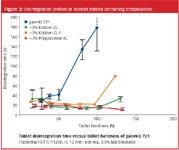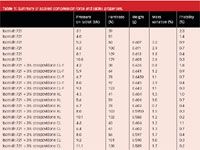Fast dissolving disintegrating tablets with isomalt
Pharmaceutical Technology Europe
During the past years, there has been increasing demand for fast dissolving disintegrating tablets (FDDTs), such as orally disintegrating tablets (ODTs) and sublinguals.
During the past years, there has been increasing demand for fast dissolving disintegrating tablets (FDDTs), such as orally disintegrating tablets (ODTs) and sublinguals. An ODT is a solid dosage form containing medicinal substances that disintegrates rapidly in the oral cavity and disperses in the saliva without the need of water.1 Besides convenience of intake, the advantage of this dosage form is fast bioavailability of the active ingredient.

Today, several technologies are widely used for the manufacture of FDDTs. The most common ones are lyophilization, molding and direct compression. However, the number of filler/binders that can be used for FDDT formulations is limited because these bulk excipients have to fulfil special requirements, such as being soluble in water, having a pleasant (sweet) taste and mouth feel, as well as being rapidly dispersible.
A direct-compression FDDT formulation usually contains — apart from the API — a diluent, disintegrant, lubricant, flavouring, sweetener and, sometimes, colourant. The most commonly used bulk excipients for the development of this kind of formulations are sucrose, mannitol and spray-dried lactose, which have been used for years in chewable tablets because of their favourable characteristics. A popular way to enhance disintegration properties is the addition of super-disintegrants, such as croscarmellose sodium, sodium starch glycolate and crospovidone.2
A new approach in this field has been made with isomalt, known as galenIQ from BENEO-Palatinit (Germany), which is used as diluent and filler/binder for direct compression. Isomalt is a polyol that has been widely used for more than 20 years as a bulk sweetener in sugar-free confectionery and nutraceutical products. A new range of pharmaceutical-grade isomalt suitable for any type of oral solid dosage form has been developed and introduced to the market.
The isomalt excipients are of nonanimal origin. They are derived from sucrose through its enzymatic transglucosilation into the disaccharide 6-O-α-D-glucopyranosyl fructose, a reducing compound, which is then hydrogenated resulting in the stereoisomer disaccharide alcohol 1-O-α-D-glucopyranosyl-D-mannitol dihydrate (1,1-GPM dihydrate) and 6-O-α-D-glucopyranosyl-D-sorbitol (1,6-GPS) in an approximate equimolecular mixture.3 Through additional processing, the ratio between the two molecular components can be varied, resulting in grades with different solubility that can be used in a number of applications from slow release to very fast disintegrating formulations. In its final state, isomalt is a white, odourless, water-soluble, crystalline powder that complies with the isomalt European Pharmacopoeia (Ph. Eur.), British Pharmacopoeia and US Pharmacopoeia National Formulary monographs.
Particularly in tableting, the direct compressible isomalt grades 720 and 721 gained a lot of interest as an alternative to traditionally used bulk excipients because of their multifunctionality as a filler and a binder. Their high-dilution potential, as well as their unique morphology, ease the development of both high and low dosage formulations. High-agglomerate stability and superior flow properties facilitate isomalt handling in the tableting process. These two grades differ in solubility producing tablet formulations with different disintegration times.
This article describes the use of pharmaceutical isomalt excipients for direct compression in the formulation of fast disintegrating tablets.
Materials and methods
The following materials were used:
- Isomalt galenIQ-720 and 721 from BENEO-Palatinit GmbH (Germany) was used as filler/binder up to 99.5% (used besides lubricant and superdisintegrant to fill to 100%); Crospovidone NF Polyplasdone XL and XL-10 from ISP Corp. (Wayne, NJ, USA) and Kollidon CL, Kollidon CL-SF and Kollidon CL-M from BASF (Germany), sodium starch glycolate ExploTab from JRS Rettenmeier (Germany) and croscarmellose sodium Nymcel ZSX-W from Noviant (The Netherlands) were used as superdisintegrants to the percentage indicated in Figure 1 and 2, as well as in Table 1. Magnesium stearate from Merck KG (Germany) was used as a lubricant at 0.5 % w/w in all formulations.
Tablets were produced on 24 stations equipped with 12 punches fully instrumented tableting press (P1200iG; FETTE, Germany) using a 12 mm concave tooling at 50 rpm and 3–11 kN compression force (Table 1). The target tablet weight was 600 mg. Tablet crushing strength was measured on a tablet hardness tester (TBH 300; ERWEKA, Germany). Tablet friability was measured on a friability tester (ERWEKA) following Ph.Eur. methodology. Tablet disintegration time was tested using a tablet disintegration tester (ERWEKA ZT 300).
Results and discussion
Even without superdisintegrants, tablets containing both isomalt grades disintegrated quickly, within 200–500 s (Figure 1). However, as a very fast disintegration is required, the grade 721 with higher solubility produced very good disintegration results. Therefore, it was decided to use this in all subsequent tests and in the formulation of FDDTs.

Figure 1
Superdisintegrants, such as croscarmellose sodium and sodium starch glycolate, which are commonly used at approximately 2–20% w/w in FDDT formulations, have been investigated in isomalt-based tablets. Preliminary tests had shown that best results were obtained when adding 2–3% w/w of a superdisintegrant to the tablet formulation.
The addition of sodium starch glycolate did not lead to shorter disintegration times. However, 2% w/w croscarmellose sodium was sufficient to decrease disintegration time of tablets with 60 N mechanical strength (Figure 2) to 30–40 s.

Figure 2
In a next step, different grades and concentrations of crospovidone as superdisintegrant were tested.
Best results were obtained using 3% w/w of the coarse crospovidone grade (Figure 3). Very short disintegration times of less than 20 s that were independent of tablet mechanical strength were obtained. Additions of 5% w/w crospovidone did not lead to faster disintegration.

Figure 3
The addition of crospovidone also had a positive effect on tablet weight variation compared to a placebo formulation. Nevertheless, total weight variation was very much within the Pharmacopeial requirements in all the produced tablets (Table 1).

Table 1: Summary of applied compression force and tablet properties.
The coarser grades of crospovidone led to a slight reduction in tablet mechanical strength, but still very low compression forces were required. Conversely, a positive effect of crospovidone on tablet friability was observed.

On the go...
Summary
Isomalt pharmaceutical excipients possess outstanding tableting properties. Grades with different solubilities are available for producing tablets with different disintegration times. In this study, isomalt grade galenIQ 721 was found to have the best performance when combined with superdisintegrants. In placebo formulations, crospovidone produced the shortest disintegration time of <20 s, which was independent of tablet mechanical strength.
In addition to the unique combination of physico-chemical, physiological and technological properties, the pleasant taste of galenIQ makes it an ideal excipient for the formulation of mechanically strong, stable and fast disintegrating tablets.
Maj-Britt Babbel is Area Manager Sales and Technical Services PHARMA at BENEO-Palatinit GmbH (Germany).
Bodo Fritzsching is Head of Sales & Technical Servic PHARMA at BENEO-Palatinit GmbH (Germany).
References
1. FDA Guidance for Industry — Orally Disintegrating Tablets, December 2008. www.fda.gov.
2. W. Camarco, D. Ray and A. Druffner, Pharm. Tech., 30(10), 28–37 (2006).
3. S.C. Ziesenitz, "Basic structure and metabolism of isomalt" in T.H. Grenby, Ed, Advances in Sweeteners (Blackie A&P London, UK, 1996) pp 109–133.
Drug Solutions Podcast: Applying Appropriate Analytics to Drug Development
March 26th 2024In this episode of the Drug Solutions Podcast, Jan Bekker, Vice President of Business Development, Commercial and Technical Operations at BioCina, discusses the latest analytical tools and their applications in the drug development market.
